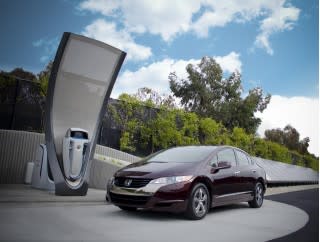Toyota Tackles Hydrogen Fueling Challenges As Mirai Launch Approaches: UPDATED

As this autumn's launch of the 2016 Toyota Mirai fuel-cell car approaches, its maker is taking steps to ensure that the small number of initial buyers and lessees will be able to fuel up their hydrogen-powered sedans with ease.
Some of the 70 or so Hyundai Tucson Fuel Cell SUV drivers in Southern California have complained that they can't reliable refuel their cars, which they've leased over the last year.
But Toyota notes that those stations aren't "ready for prime time," and wouldn't necessarily be capable of fueling a new Mirai.
DON'T MISS: CA Fuel-Cell Car Drivers Say Hydrogen Fuel Unavailable, Stations Don't Work
In a recent interview published in Forbes, Toyota's Craig Scott notes that "there's still a lot of development work that needs to occur" on a hydrogen fueling infrastructure, and that while it's "vastly improved this year," its development is "still lagging."
"I often say that the infrastructure is a generation behind the vehicle," Scott said. He is Toyota's national alternative fuels manager.
[EDITOR'S NOTE: Toyota contacted Green Car Reports to correct and expand upon Mirai fueling allowances. We've added that material on page 2.]
California now has 48 hydrogen stations planned and funded, with two completed and another eight now under construction. Toyota expects 10 to 15 stations "open and ready" by the end of the year and capable of fueling its Mirai.

Next year, Scott said, he expects roughly 20 more stations to open.
Like Hyundai, Toyota will only offer its Mirai to customers who live and work near hydrogen stations. So far, it has designated only eight dealers--four each in Northern and Southern California--to distribute the hydrogen-powered vehicles.
Scott noted that unlike Japan, where the government is firmly behind the establishment of a nationwide hydrogen fueling infrastructure, the U.S. has no national policy to support and fund such a network.
Japan's efforts, he said, include a "simplified and standardized approval process for permitting, which is something we’re sorely lacking in the U.S."
ALSO SEE: Why Do Fuel-Cell Vehicles Make Electric-Car Advocates So Crazy?
More insight into Toyota's approach to marketing the Mirai and addressing concerns over fuel availability come from Southern California reader Doug Kerr.
The owner of two electric cars, he was invited to a Mirai introduction event in Laguna Beach put on by the carmaker.
The gathering included video presentations, explanations of how a hydrogen fuel-cell powertrain functions, and a half-hour Mirai test drive.
Kerr characterized the event as "low-key and targeted to those early adopters who had the income and the technical interest sufficient to become a hydrogen pioneer."

Knowledgeable electric-car drivers, including Kerr, may raise questions about the car and the technology, as Kerr did. He writes:

 Yahoo Autos
Yahoo Autos 
